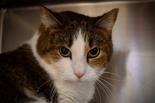by Dennis Dalman
This time of year, you see in your yard a cat that looks lost, as if it’s looking for something to eat, for a warm place to cuddle up, for a shelter from the storm.
After some thought, you decide maybe to try to capture it to save its life. But then what?
The first thing to do is to call the Tri-County Humane Society and tell them about the cat, said Anna Stratton, customer-service manager for the TCHS.
By sharing information about the cat, TCHS animal experts can help determine if the cat may be a domesticated animal that is lost or one that was abandoned or if the creature may be a feral (wild) cat.
Another good reason to call immediately is the TCHS keeps track of each call and each cat description so if the cat is lost, the owner can be contacted. Many owners who cannot find their cats call the TCHS, so their information is on record, too. What’s more, many lost cats have been equipped with an implanted micro-chip that can be read electronically at the TCHS, so its owner can be notified if/when the cat has been found.
As a rule, feral cats are leery, suspicious and will not approach people; they’ll run off in fright.
“There are lots of them in this area,” Stratton said.
It is OK to feed feral cats and provide some kind of warm shelter (like a big box lined with blankets), but people should avoid trying to touch or pick up a wild cat. They often carry diseases, including possibly rabies.
Female feral cats, of course, will sometimes have litters of kittens. Those kittens can usually be “saved” (socialized with humans) if rescued within six or so weeks after their births.
As the weather gets colder, the “cat problem” increases, Stratton noted. Put simply, there are just not enough cages to hold all the surrendered cats and kittens. While the humane society does have a successful foster program, there are still not enough resources to handle a big influx of cats or kittens.
If someone does plan to capture a cat in a live-trap cage, that person should immediately call TCHS and discuss the plan with staff. That way, an appointment can be made and a cage made available.
Animal experts believe it is inhumane to keep a feral cat in a cage for much more than a day or two because the animal becomes extremely stressed in confinement, Stratton noted. For years, feral cats brought to the TCHS often had to be euthanized as they simply could not be domesticated. In more recent years, such cats would be placed on farms to become “barn cats” after being spayed or neutered.
Stratton said other signs of feral cats include the following:
• The critter will approach to eat food left out for them, but they will run off as if terrified if a human approaches them while feeding. (In some cases, however, domesticated but abandoned cats can show that kind of fear, too.)
• Feral cats tend not to meow at all whereas domesticated cats will usually meow around people.
“Feral cats are very resourceful,” Stratton said. “They have an ability to find food and shelter, like other animals such as rabbits and squirrels. But feral cats usually have shorter life spans than domesticated cats.”
Typically, at any given time, there are about 100 cats up for adoption at the TCHS, Stratton said.
Stratton has been with the TCHS for 13 years and considers the staff and customers to be a close-knit community with a “ma-and-pa” family feel, she noted.
“It’s great for our staff morale knowing animals here are as comfortable as they can possibly be,” she said. “It’s always a learning experience, and it’s ever-evolving.”
The new building at its east St. Cloud site is twice the size of the previous facility and is working out so well, said Stratton, with more room for the animals and for the staff.
Stratton emphasized once again her advice about animal-surrender procedures:
“Call us immediately and we can set up a plan,” she said.
The number for TCHS is 320-252-0896.
To learn more about animals, adoption and volunteer opportunities or to donate, visit the TCHS site at tricountyhumanesociety.org.
TCHS also has a pressing need for more foster-home volunteers for injured or sick animals, pregnant animals, orphaned animals, socialization times and to care for animals where there are overflow surrenders during peak periods.
Information about what it takes to be a foster “parent” is on the TCHS website.
In 2019, the TCHS fostered out 1,161 animals, placed for adoption 3,668 animals, spayed/neutered 2,214 animals and performed surgery on 2,350.

Up for adoption, “Pretty Girl” is one of many cats at the Tri-County Humane Society that need forever homes. Pretty Girl is a spayed female domestic shorthair/mix who is about 2.5 years old.


